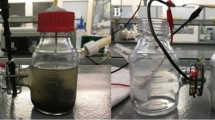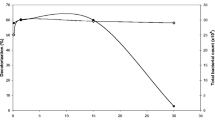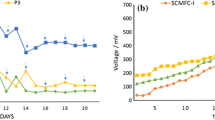Abstract
The objectives of this study were to investigate the simultaneous bioelectricity generation and decolorization of methyl orange (MO) in the anode chamber of microbial fuel cells (MFCs) in a wide concentration range (from 50 to 800 mg L−1) and to reveal the microbial communities on the anode after the MFC was operated continuously for more than 6 months using MO-glucose mixtures as fuel. Interestingly, the added MO played an active role in the production of electricity. The maximum voltage outputs were 565, 658, 640, 629, 617, and 605 mV for the 1 g L−1 glucose with 0, 50, 100, 200, 300, and 500 mg L−1 of MO, respectively. The results of three groups of comparison experiments showed that accelerated decolorization of methyl orange (MO) was achieved in the MFC as compared to MFC in open circuit mode and MFC without extra carbon sources. The decolorization efficiency decreased with an increase of MO concentration in the studied concentration range for the dye load increased. A 454 high-throughput pyrosequencing revealed the microbial communities. Geobacter genus known to generate electricity was detected. Bacteroidia class, Desulfovibrio, and Trichococcus genus, which were most likely responsible for degrading methyl orange, were also detected.





Similar content being viewed by others
References
Alaton IA, Balcioglu IA, Bahnemann DW (2002) Advanced oxidation of a reactive dye bath effluent: comparison of O3, H2O2/UVC and TiO2/UVA processes. Water Res 36:1143–1154
Bond DR, Lovley DR (2003) Electricity production by Geobacter sulfurreducens attached to electrodes. Appl Environ Microbiol 69:1548–1555
Cao Y, Hu Y, Sun J, Hou B (2010) Explore various co-substrates for simultaneous electricity generation and Congo red degradation in air-cathode single-chamber microbial fuel cell. Bioelectrochemistry 79:71–76
Chen B, Meng M, Chang C (2010) Assessment upon azo dye decolorization and bioelectricity generation by Proteus hauseri. Bioresour Technol 101:4737–4741
Chen S, Hu M, Liu J, Zhong G, Yang L, Rizwan-ul-Haq M, Han H (2011) Biodegradation of beta-cypermethrin and 3-phenoxybenzoic acid by a novel Ochrobactrum lupine DG-S-01. J Hazard Mater 187:433–440
Cheng SA, Liu H, Logan BE (2006) Power densities using different cathode catalysts (Pt and CoTMPP) and polymer binders (Nafion and PTFE) in single chamber microbial fuel cells. Environ Sci Technol 40:364–369
Choi Y, Kim N, Kim S (2003) Dynamic behaviors of redox mediators within the hydrophobic layers as an important factor for effective microbial fuel cell operation. Bull Korean Chem Soc 24:437–440
Cui D, Guo YQ, Cheng HY, Liang B, Kong FY, Lee HS, Wang AJ (2012) Azo dye removal in a membrane-free up-flow biocatalyzed electrolysis reactor coupled with an aerobic bio-contact oxidation reactor. J Hazard Mater 239–240:257–264
Cui D, Guo YQ, Lee HS, Cheng HY, Liang B, Kong FY, Wang YZ, Huang LP, Xu MY, Wang AJ (2014) Efficient azo dye removal in bioelectrochemical system and post-aerobic bioreactor: optimization and characterization. Chem Eng J 243:355–363
Ding HR, Li Y, Lu AH, ** S, Quan C, Wang CQ, Wang X, Zeng CP, Yan YH (2010) Photocatalytically improved azo dye reduction in a microbial fuel cell with rutile-cathode. Bioresource Technol 101:3500–3505
Dos Santos AB, Cervantes FJ, Van Lier JB (2007) Review paper on current technologies for decolourisation of textile wastewaters: perspectives for anaerobic biotechnology. Bioresource Technol 98:2369–2385
Du ZW, Li HR, Gu TY (2007) A state of the art review on microbial fuel cells: a promising technology for wastewater treatment and bioenergy. Biotechnol Adv 25:464–482
Dutta K, Mukhopadhyay S, Bhattacharjee S, Chaudhuri B (2001) Chemical oxidation of methylene blue using a Fenton-like reaction. J Hazard Mater 84:57–71
Fan J, Guo YH, Wang JJ, Fan MH (2009) Rapid decolorization of azo dye methyl orange in aqueous solution by nanoscale zerovalent iron particles. J Hazard Mater 166:904–910
Feng CH, Li FB, Mai HJ, Li XZ (2010) Bio-electro-Fenton process driven by microbial fuel cell for wastewater treatment. Environ Sci Technol 44:1875–1880
Fernando E, Keshavarz T, Kyazze G (2014a) External resistance as a potential tool for influencing azo dye reductive decolourisation kinetics in microbial fuel cells. Int Biodeter Biodegr 89:7–14
Fernando E, Keshavarz T, Kyazze G (2014b) Complete degradation of the azo dye Acid Orange-7 and bioelectricity generation in an integrated microbial fuel cell, aerobic two-stage bioreactor system in continuous flow mode at ambient temperature. Bioresource Technol 156:155–162
Galindo C, Jacques P, Kalt A (2000) Photodegradation of the aminoazobenzene acid orange 52 by three advanced oxidation processes: UV/H2O2, UV/TiO2 and VIS/TiO2: comparative mechanistic and kinetic investigations. J Photochem Photobiol A: Chem 130:35–47
Garcia-Mancha N, Puyol D, Monsalvo VM, Rajhi H, Mohedano AF, Rodriguez JJ (2012) Anaerobic treatment of wastewater from used industrial oil recovery. J Chem Technol Biotechnol 87:1320–1328
Hosseini MG, Ahadzadeh I (2013) Electrochemical impedance study on methyl orange and methyl red as power enhancing electron mediators in glucose fed microbial fuel cell. J Taiwan Inst of Chem E 44:617–621
Ji JY, Jia YJ, Wu WG, Bai LL, Ge LQ, Gu ZZ (2011) A layer-by-layer self-assembled Fe2O3 nanorod-based composite multilayer film on ITO anode in microbial fuel cell. Colloids Surf A: Physicochem Eng Aspects 390:56–61
Jung S, Regan JM (2007) Comparison of anode bacterial communities and performance in microbial fuel cells with different electron donors. Appl Microbiol Biotechnol 77:393–402
Liu RH, Sheng GP, Sun M, Zhang GL, Li WW, Tong ZH, Dong F, Michael H-WL YHQ (2011) Enhanced reductive degradation of methyl orange in a microbial fuel cell through cathode modification with redox mediators. Appl Microbiol Biotechnol 89:201–208
Logan BE (2007) Microbial fuel cells. John Wiley & Sons, New York
Logan BE (2009) Exoelectrogenic bacteria that power microbial fuel cells. Nat Rev Microbiol 7:375–381
Logan BE, Aelterman P, Hamelers B, Rozendal R, Schröeder U, Keller J, Freguiac S, Verstraete W, Rabaey K (2006) Microbial fuel cells: methodology and technology. Environ Sci Technol 40:5181–5192
Macdonald JR (1992) Impedance spectroscopy. Ann Biomed Eng 20:289–305
Min B, Kim JR, Regan JM, Logan BE (2005) Electricity generation from swine wastewater using microbial fuel cells. Water Res 39:4961–4968
Morris JM, ** S, Crimi B, Pruden A (2009) Microbial fuel cell in enhancing anaerobic biodegradation of diesel. Chem Eng J 146:161–167
Mu Y, Rabaey K, Rozendal RA, Yuan Z, Keller J (2009) Decolorization of azo dyes in bioelectrochemical systems. Environ Sci Technol 43:5137–5143
Nimje VR, Chen CY, Chen CC, Jean JS, Reddy AS, Fan CW, Pan KY, Liu HT, Chen JL (2009) Stable and high energy generation by a strain of Bacillus subtilis in a microbial fuel cell. J Power Sources 190:258–263
Oh S, Logan BE (2006) Proton exchange membrane and electrode surface areas as factors that affect power generation in microbial fuel cells. Appl Microbiol Biotechnol 70:162–169
Pandey A, Singh P, Iyengar L (2007) Bacterial decolorization and degradation of azo dyes. Int Biodeterior Biodegrad 59:73–84
Park DH, Zeikus JG (2000) Electricity generation in microbial fuel cells using neutral red as an electronophore. Appl Environ Microbiol 66:1292–1297
Rabaey K, Boon N, Siciliano SD, Verhaege M, Verstraete W (2004) Biofuel cells select for microbial consortia that self-mediate electron transfer. Appl Environ Microbiol 70:5373–5382
Rajaguru P, Kalaiselvi K, Palanivel M, Subburam V (2000) Biodegradation of azo dyes in a sequential anaerobic–aerobic system. Appl Microbiol Biotechnol 54:268–273
Read ST, Dutta P, Bond PL, Keller J, Rabaey K (2010) Initial development and structure of biofilms on microbial fuel cell anodes. BMC Microbiol 10:98–107
Ryckelynck N, Stecher HA, Reimers CE (2005) Understanding the anodic mechanism of a seafloor fuel cell: interactions between geochemistry and microbial activity. Biogeochemistry 76:113–139
Solanki K, Subramanian S, Basu S (2013) Microbial fuel cells for azo dye treatment with electricity generation: a review. Bioresource Technol 131:564–571
Solis M, Solis A, Perezb HI, Manjarrezb N, Flores M (2012) Microbial decolouration of azo dyes: a review. Process Biochem 47:1723–1748
State environmental protection administration of china, (2006) Standard methods for the examination of water and wastewater, 4th edn. China Environmental Science Press, Bei**g
Stolz A (2001) Basic and applied aspects in the microbial degradation of azo dyes. Appl Microbiol Biotechnol 56:69–80
Sun J, Hu YY, Bi Z, Cao YQ (2009) Simultaneous decolorization of azo dye and bioelectricity generation using a microfiltration membrane air-cathode single-chamber microbial fuel cell. Bioresource Technol 100:3185–3192
Sun J, Hu YY, Hou B (2011) Electrochemical characterization of the bioanode during simultaneous azo dye decolorization and bioelectricity generation in an air-cathode single chambered microbial fuel cell. Electrochim Acta 56:6874–6879
Sun J, Li YM, Hu YY, Hou B, Zhang YP, Li SZ (2013) Understanding the degradation of Congo red and bacterial diversity in an air–cathode microbial fuel cell being evaluated for simultaneous azo dye removal from wastewater and bioelectricity generation. Appl Microbiol Biotechnol 97:3711–3719
Sund CJ, McMasters S, Crittenden SR (2007) Effect of electron mediators on current generation and fermentation in a microbial fuel cell. Appl Microbiol Biotechnol 76:561–568
Wang SS, Huang LP, Gan LL, Quan X, Li N, Chen GH, Lu L, **ng DF, Yang FL (2012) Combined effects of enrichment procedure and non-fermentable or fermentable co-substrate on performance and bacterial community for pentachlorophenol degradation in microbial fuel cells. Bioresource Technol 120:120–126
Wang YZ, Wang AJ, Liu WZ, Kong DY, Tan WB, Liu C (2013a) Accelerated azo dye removal by biocathode formation in single-chamber biocatalyzed electrolysis systems. Bioresource Technol 146:740–743
Wang YZ, Wan AJ, Liu WZ, Sun Q (2013b) Enhanced azo dye removal through anode biofilm acclimation to toxicity in single-chamber biocatalyzed electrolysis system. Bioresource Technol 142:688–692
Wei LL, Han HL, Shen JQ (2012) Effects of cathodic electron acceptors and potassium ferricyanide concentrations on the performance of microbial fuel cell. Int J Hydrogen Energy 37:12980–12986
Wen Q, Kong FY, Zheng HT, Yin JL, Cao DX, Ren YM, Wang GL (2011a) Simultaneous processes of electricity generation and ceftriaxone sodium degradation in an air-cathode single chamber microbial fuel cell. J Power Sources 196:2567–2572
Wen Q, Kong FY, Zheng HT, Cao DX, Ren YM, Yin JL (2011b) Electricity generation from synthetic penicillin wastewater in an air-cathode single chamber microbial fuel cell. Chem Eng J 168:572–576
Yang Q, Wang J, Wang H, Chen X, Ren S, Li X, Xu Y, Zhang H, Li X (2012) Evolution of the microbial community in a full-scale printing and dyeing wastewater treatment system. Bioresour Technol 117:155–163
Yoo ES, Libra J, Adrian L (2001) Mechanism of decolorization of azo dyes in anaerobic mixed culture. J Environ Eng 127:844–849
Acknowledgment
The authors are grateful for the financial support from the Plan for Scientific Innovation Talent of Henan Province (Grant No. 134200510014), Basic and Cutting-Edge Technology Research Project of Henan province, People’s Republic of China (Grant No. 112300410157), and the Innovation Scientists and Technicians Troop Construction Projects of Henan Province.
Author information
Authors and Affiliations
Corresponding author
Additional information
Responsible editor: Gerald Thouand
Rights and permissions
About this article
Cite this article
Guo, W., Feng, J., Song, H. et al. Simultaneous bioelectricity generation and decolorization of methyl orange in a two-chambered microbial fuel cell and bacterial diversity. Environ Sci Pollut Res 21, 11531–11540 (2014). https://doi.org/10.1007/s11356-014-3071-9
Received:
Accepted:
Published:
Issue Date:
DOI: https://doi.org/10.1007/s11356-014-3071-9




